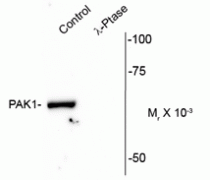ARG52386
anti-PAK1 phospho (Thr84) antibody
anti-PAK1 phospho (Thr84) antibody for Western blot and Human,Mouse
Cancer antibody; Cell Biology and Cellular Response antibody; Cell Death antibody; Microbiology and Infectious Disease antibody; Neuroscience antibody; Signaling Transduction antibody
Overview
| Product Description | Rabbit Polyclonal antibody recognizes PAK1 phospho (Thr84) |
|---|---|
| Tested Reactivity | Hu, Ms |
| Predict Reactivity | Bov, Rat, Chk, Dog, NHuPrm, Sheep, Zfsh |
| Tested Application | WB |
| Host | Rabbit |
| Clonality | Polyclonal |
| Isotype | IgG |
| Target Name | PAK1 |
| Antigen Species | Human |
| Immunogen | Synthetic phospho-peptide corresponding to amino acid residues surrounding Thr84 conjugated to KLH |
| Conjugation | Un-conjugated |
| Alternate Names | PAKalpha; Serine/threonine-protein kinase PAK 1; Alpha-PAK; p65-PAK; EC 2.7.11.1; PAK-1; p21-activated kinase 1 |
Application Instructions
| Application Suggestion |
|
||||
|---|---|---|---|---|---|
| Application Note | Specific for the ~68k PAK1 phosphorylated at Thr84. * The dilutions indicate recommended starting dilutions and the optimal dilutions or concentrations should be determined by the scientist. |
Properties
| Form | Liquid |
|---|---|
| Purification | Affinity Purified |
| Buffer | 10 mM HEPES (pH 7.5), 150 mM NaCl, 0.1 mg/ml BSA and 50% Glycerol |
| Stabilizer | 0.1 mg/ml BSA, 50% Glycerol |
| Storage Instruction | For continuous use, store undiluted antibody at 2-8°C for up to a week. For long-term storage, aliquot and store at -20°C. Storage in frost free freezers is not recommended. Avoid repeated freeze/thaw cycles. Suggest spin the vial prior to opening. The antibody solution should be gently mixed before use. |
| Note | For laboratory research only, not for drug, diagnostic or other use. |
Bioinformation
| Database Links |
Swiss-port # Q13153 Human Serine/threonine-protein kinase PAK 1 |
|---|---|
| Gene Symbol | PAK1 |
| Gene Full Name | p21 protein (Cdc42/Rac)-activated kinase 1 |
| Background | PAKs, p21 activated kinases, are a family of serine/threonine protein kinases comprised of six isoforms, PAK1-6, and they play important roles in cytoskeleton dynamics, cell survival and proliferation (Ye et al, 2012). Each of these isoforms contains a C-terminal catalytic domain and an N-terminal regulatory domain with a small G protein binding motif (Chen et al, 2004). OSR1, oxidative stress response 1, is activated only by osmotic stresses, like sorbital or NaCl (Chen et al, 2004). It has been predicted that OSR1 phosphorylates PAK1 in the regulatory domain at thr84 and inhibits activation of JNK and MAPK pathway. (Chen et al, 2004). It has also been suggested that OSR1 may have a regulating function with actin cytoskeleton because it can phosphorylate PAK1 at thr84 and bind to gelsolin (Chen et al, 2004). |
| Research Area | Cancer antibody; Cell Biology and Cellular Response antibody; Cell Death antibody; Microbiology and Infectious Disease antibody; Neuroscience antibody; Signaling Transduction antibody |
| Calculated MW | 61 kDa |
| PTM | Autophosphorylated in trans, meaning that in a dimer, one kinase molecule phosphorylates the other one. Activated by autophosphorylation at Thr-423 in response to a conformation change, triggered by interaction with GTP-bound CDC42 or RAC1. Activated by phosphorylation at Thr-423 by BRSK2 and by PDPK1. Phosphorylated by JAK2 in response to PRL; this increases PAK1 kinase activity. Phosphorylated at Ser-21 by PKB/AKT; this reduces interaction with NCK1 and association with focal adhesion sites. |
Images (1) Click the Picture to Zoom In
-
ARG52386 anti-PAK1 phospho (Thr84) antibody WB image
Western blot: Mouse hippocampal lysate showing specific immunolabeling of the ~68k PAK1 protein phosphorylated at Thr 84 (control) stained with ARG52386 anti-PAK1 phospho (Thr84) antibody.
Phosphospecificity is shown in the second lane (lambda-phosphatase: λ-Ptase).
The blot is identical to the control except that the lysate was incubated in λ-Ptase (800 units/1mg protein for 30 min).
The immunolabeling is completely eliminated by treatment with λ-Ptase.
.






